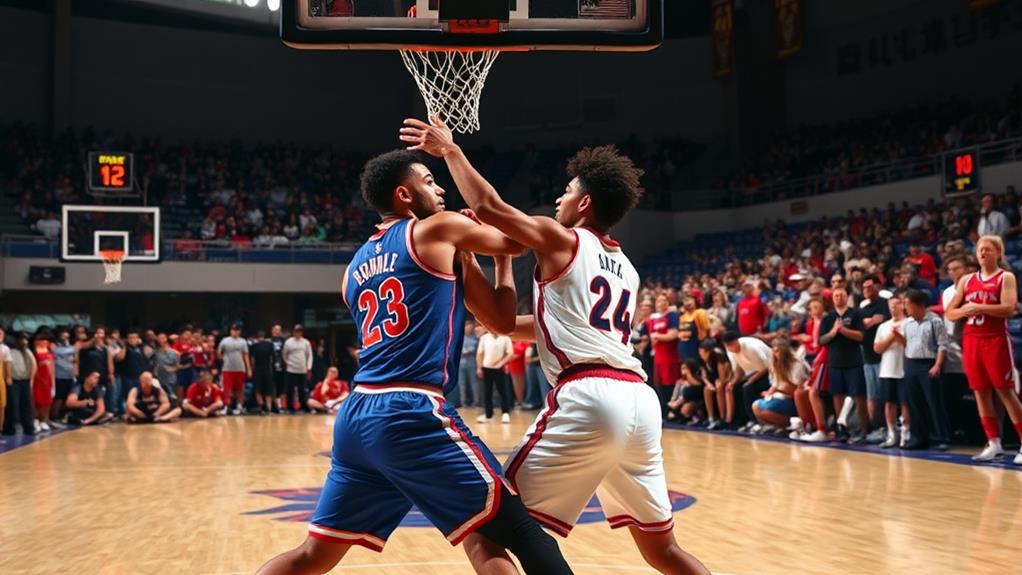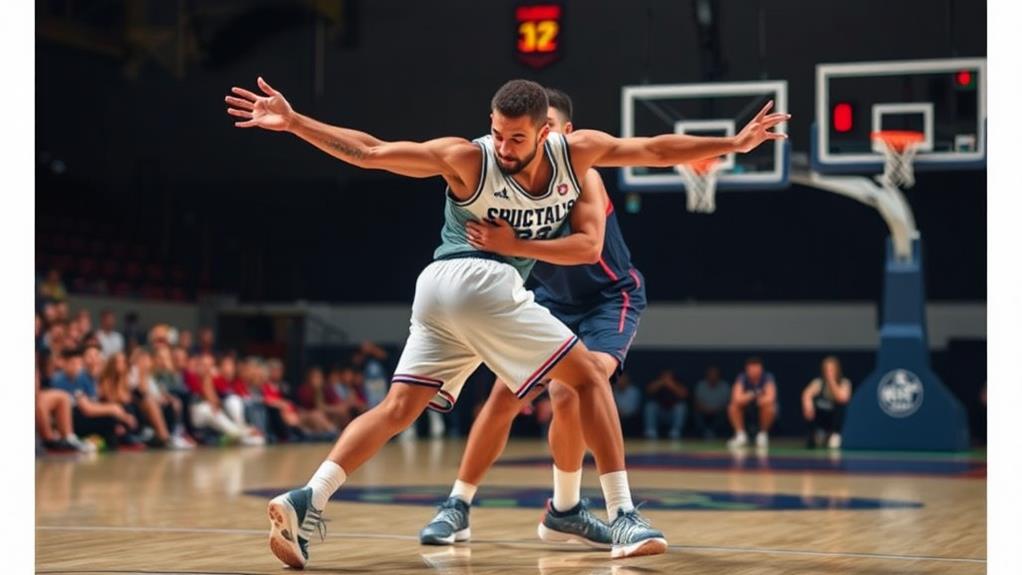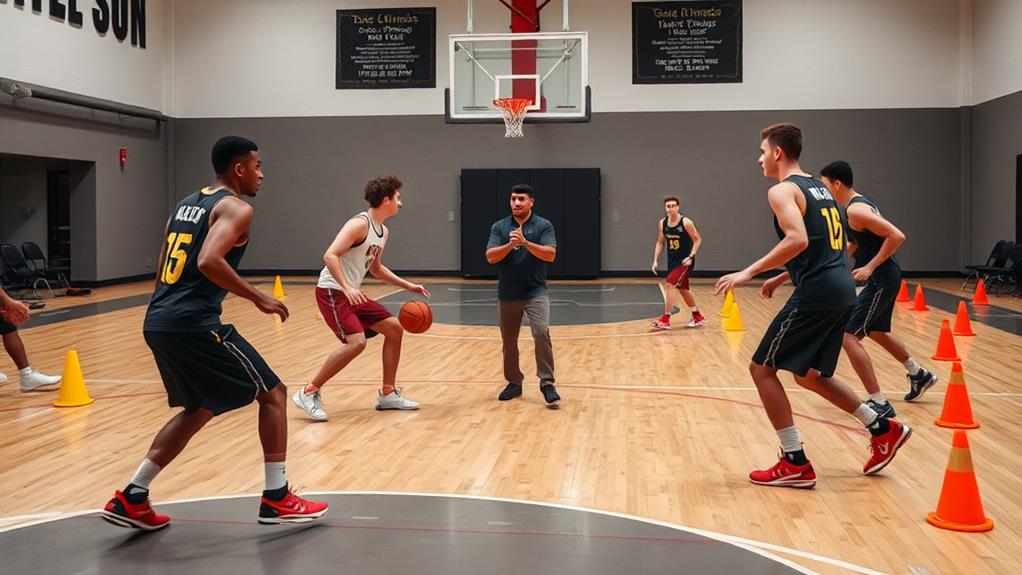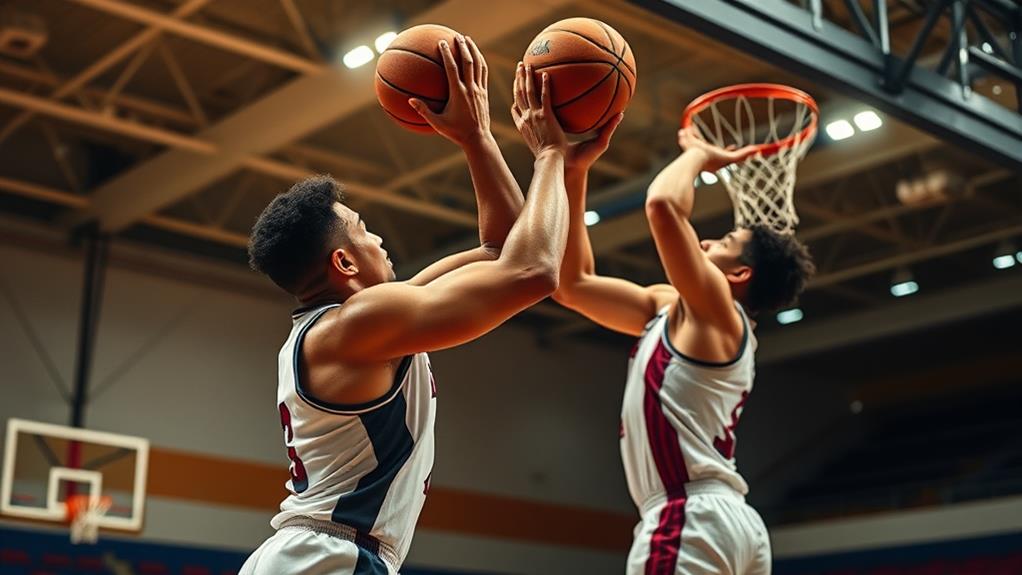
How to Effectively Box Out Your Opponent in Basketball
October 8, 2024To effectively box out your opponent in basketball, start by identifying the nearest offensive player immediately after a shot. Maintain physical contact to monitor their movements and create a solid barrier using your body. Keep a low stance with bent knees for balance, and use your arms to prevent them from getting around you. Anticipate their movements based on their tendencies, and communicate with your teammates. Practicing drills like the Box-Out Circle can enhance your skills. Master these techniques, and you'll gain a significant edge on the boards. There's more to discover about refining your boxing out strategy.
Importance of Communication
In basketball, your team's communication is vital for effective rebounding. When a shot goes up, yelling "SHOT!" alerts your teammates to prepare for the rebound. This simple verbal cue enhances their readiness and helps them focus on the ball's trajectory. Effective communication keeps everyone aware of their responsibilities, ensuring each player knows who to box out and where to position themselves on the court.
Additionally, fostering a culture of inclusivity and equality on the court can enhance teamwork and trust among players, similar to how racial integration promotes social equality in sports. When you and your teammates consistently communicate, you promote teamwork and anticipate each other's movements during plays. This accountability is essential in boxing out responsibilities, making it harder for opponents to secure rebounds. If everyone knows their role, you can limit second-chance points and gain an edge in the game.
Furthermore, teams that prioritize communication during rebounding situations often perform better overall. By securing possession and minimizing the opposing team's opportunities, you're contributing to your team's success.
Locating Your Opponent
As soon as the shot goes up, you need to quickly identify the nearest offensive player to box out effectively.
Keeping physical contact with them helps you track their movements and anticipate where they'll go for the rebound. This awareness not only boosts your chances of securing the ball but also strengthens your team's defensive strategy.
Additionally, utilizing smart defensive tactics against taller opponents can further enhance your ability to box out and control the boards, ensuring your team maintains a strong defensive presence smart defensive tactics.
Immediate Opponent Identification
Identifying your nearest opponent right after a shot is essential for effective boxing out. This immediate opponent identification allows you to determine who you need to guard, ensuring you're ready to prevent them from grabbing the rebound. As soon as the shot goes up, scan the area to locate the closest offensive player. This awareness is critical in the paint; leaving opponents unguarded can lead to easy second-chance points.
Once you've identified your opponent, position yourself strategically based on the shot's trajectory. This anticipation not only improves your chances of securing the rebound but also helps you maintain contact with the identified player. Staying close allows you to track their movements and react accordingly when the ball comes off the rim.
Effective communication with your teammates plays an essential role in this process. Yell "shot!" to alert everyone to locate their respective opponents. This call prepares your team for the rebounding phase, ensuring everyone is aware of their responsibilities.
Maintain Physical Contact
Maintaining physical contact with your nearest opponent after a shot is essential for effective rebounding. By keeping your body positioned between the opponent and the basket, you can monitor their movements and intentions, preventing them from easily securing the rebound.
Here are three key strategies to help you maintain physical contact:
- Establish Contact: Use your arms and body to create contact with your opponent. This helps you sense their movements, allowing for quicker adjustments as the ball approaches.
- Communicate with Teammates: Yell "shot" to alert your teammates. This enhances awareness of responsibilities and encourages everyone to locate their opponents swiftly, ensuring you're ready to box out.
- Stay Engaged: Continuously maintain contact, which not only aids in boxing out but also helps you anticipate the actions of offensive players. You'll be more prepared to react as the ball comes into play.
Anticipate Opponent's Movement
After securing physical contact with your opponent, the next step is to anticipate their movements. Immediately after a shot, quickly identify the nearest opponent to establish your box-out position. Keeping physical contact allows you to track their actions and prevents them from moving freely toward the basket for a rebound.
Use your peripheral vision to monitor both the ball's trajectory and your opponent's position. This dual awareness helps you react effectively. Anticipating the opponent's movement means recognizing their tendencies—whether they typically crash the boards or hang back—and adjusting your positioning accordingly.
Maintain a low stance and shuffle side-to-side to effectively counter your opponent's movements. This agility allows you to stay in a superior position for the rebound, making it harder for them to slip past you.
Effective Sealing Techniques

To effectively seal off your opponent in basketball, you need to adopt a solid stance that maximizes your stability. Start by maintaining a wide stance with bent knees, which lowers your center of gravity. This position gives you strength against pushes from the player trying to box you out.
Just as in soccer, where effective communication among players enhances team dynamics, being aware of your positioning and movements can greatly impact your rebounding success.
Here are three sealing techniques to keep in mind:
- Create a Barrier: Extend your arms outward, making sure to keep your elbows out to avoid fouls while establishing control over the space between you and your opponent.
- Stay Low and Use Your Hips: Keep your body low and use your hips to push against your opponent. This will disrupt their movement and prevent them from maneuvering around you with ease.
- Utilize Peripheral Vision: Track the ball's trajectory while maintaining contact with your opponent. This allows you to react quickly when a shot is taken, essential for effective rebounding.
Backing Down Strategies
When you're backing down from the hoop, your goal is to create space between you and your opponent, which sets you up for an effective rebound. To do this, focus on your body positioning.
Lower your center of gravity and bend your knees to maintain balance and leverage. This stance allows you to push your opponent away, ensuring you secure your spot for the rebound.
Additionally, employing effective spacing techniques can further enhance your ability to box out.
Timing is vital when backing down. Initiate your move as the shot goes up, maximizing your chances of gaining the upper hand.
Even if you don't grab the rebound, your actions can disrupt the opponent's movement, increasing the likelihood of a teammate snatching the ball.
Drills for Rebounding Skills

To sharpen your rebounding skills, you should incorporate specific drills into your practice routine.
Understanding the importance of positioning is essential for effective box-outs, as it can greatly impact your team's performance. The Box-Out Circle Drill helps you compete for positioning, while the PowerUp Positioning Exercise gets you ready to establish your box-out quickly before shots.
Additionally, mastering the field dimensions and equipment requirements will enhance your overall game awareness.
Don't forget the UCLA Rebounding Practice to refine your footwork and enhance your overall effectiveness in securing rebounds.
Box-Out Circle Drill
Engage in the Box-Out Circle Drill to sharpen your rebounding skills and boost your team's performance. This drill emphasizes spatial awareness and simulates the physicality of rebounding in a game.
Here's how you can make the most of it:
- Formation: Gather players in a circle. Each participant will face an opponent to practice boxing out effectively.
- Cue: When a player calls out "shot!", everyone initiates their box-out techniques. This not only reinforces the mechanics but also enhances communication skills on the court.
- Rotation: Regularly rotate players so they can box out against different opponents. This adaptability is essential for real-game scenarios.
PowerUp Positioning Exercise
Building on the skills developed in the Box-Out Circle Drill, the PowerUp Positioning Exercise takes rebounding techniques to the next level. This drill emphasizes early positioning, urging you to anticipate missed shots and establish your box-out stance before the ball is released. By doing this, you promote proactive rebounding strategies that can notably improve your game.
During the PowerUp Drill, you'll practice pushing back against your opponent, maintaining a low center of gravity for enhanced stability and leverage. This technique is essential when securing your position in the paint. The competitive scenarios included in this drill foster spatial awareness, enabling you to navigate effectively around other players while securing rebounds.
Regular practice of the PowerUp Positioning Exercise can lead to improved rebounding statistics, demonstrating that positioning often outweighs size in boxing out opponents.
Furthermore, the drill simulates live-game conditions, allowing you to experience the pressure of rebounding situations and refine your timing for snatching the basketball. Incorporating this exercise into your training routine will sharpen your rebounding skills and elevate your overall performance on the court.
UCLA Rebounding Practice
The UCLA Rebounding Drill sharpens your rebounding skills by emphasizing early positioning and effective box-out techniques.
This drill is essential for young athletes looking to improve their game. During practice, you'll react to a simulated shot while using proper box-out methods to secure the rebound.
Here's what you need to focus on:
- Strong Stance: Maintain bent knees and wide feet to enhance your balance and stability.
- Dynamic Movements: Shuffle and pivot based on the ball's position, mimicking real-game scenarios.
- Communication: Yell "shot!" to alert your teammates, initiating your box-out efforts.
Defensive Strategies for Boxing Out
Success in boxing out hinges on effective defensive strategies that guarantee you control the rebounding area. In man-to-man defense, it's essential to box out your assigned offensive player immediately after the shot. This accountability prevents easy rebounds and keeps you in the game.
As defenses evolve, incorporating historical shifts in defensive approaches can further enhance your boxing out technique. On the other hand, when playing zone defense, effective communication is key. Make sure you identify and box out the nearest offensive player, ensuring all threats are covered during the rebounding effort.
Adjust your boxing out technique based on your opponent's shooting tendencies. If a player consistently misses long shots, position yourself further from the basket to secure the rebound.
Utilize your body to push back against the offensive player while maintaining a low stance; this helps you stay balanced and gain leverage in the rebounding battle.
Physical Conditioning for Rebounding

Rebounding effectively in basketball requires more than just skill; it demands a solid foundation of physical conditioning. Focusing on key areas will help you elevate your game and secure more rebounds. Here are three essential components to incorporate into your training:
1. Vertical Jump: Improve your vertical leap through explosive strength training, like squats and plyometrics. This will enhance your ability to reach for the ball during rebounds.
Additionally, incorporating endurance training methods can help you maintain your vertical explosiveness throughout the game.
2. Agility Drills: Incorporate agility drills into your routine to boost your reaction time and positioning. Quick lateral movements will allow you to respond effectively when the ball comes off the rim.
Dynamic drills that enhance agility are critical for improving your overall court performance.
3. Endurance Training: Build your stamina through endurance training. Staying physically competitive throughout the game is essential, especially when fatigue sets in during intense rebounding situations.
Additionally, don't overlook flexibility exercises. They reduce the risk of injury during those intense battles for the ball, helping you execute proper boxing out techniques without any hindrance.
Mastering Advanced Techniques
Mastering advanced boxing out techniques can greatly elevate your rebounding game. Start by maintaining a low center of gravity with bent knees and wide feet. This athletic stance enhances your stability, making it tougher for an offensive player to push past you.
Focus on utilizing your hip movement and leg strength to create a solid barrier, effectively disrupting your opponent's ability to secure rebounds. Additionally, a center's role in defensive versatility can inform your boxing out strategy, as understanding how to protect the rim can enhance your rebounding effectiveness.
Incorporate peripheral vision in your practice, allowing you to track both the ball and your opponent's movements. This skill guarantees you can react quickly and adjust your positioning.
To master the art of boxing out, practice the sequence: hit, turn, drive, and pursue. This four-step process is essential for executing successful box outs in competitive situations.
Additionally, recognize and adapt to the shooting tendencies of your opponents. By anticipating rebound trajectories, you can position yourself more effectively.
Conclusion
As the final buzzer approaches, you can feel the intensity in the air. Picture yourself positioning your body, arms spread wide like a strong oak tree, ready to absorb any challenge. You've mastered the art of boxing out, anticipating your opponent's moves while communicating with your teammates like a well-oiled machine. With your heart racing, you leap, claiming that hard-fought rebound, the crowd erupting around you. This is the moment you've trained for—where skill meets strategy, and victory is within reach.


